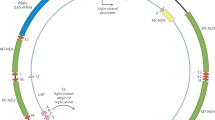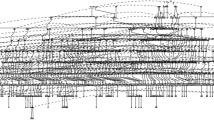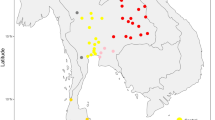Abstract
To function properly, mitochondria utilize products of 37 mitochondrial and >1,000 nuclear genes, which should be compatible with each other. Discordance between mitochondrial and nuclear genetic ancestry could contribute to phenotypic variation in admixed populations. Here, we explored potential mitonuclear incompatibility in six admixed human populations from the Americas: African Americans, African Caribbeans, Colombians, Mexicans, Peruvians and Puerto Ricans. By comparing nuclear versus mitochondrial ancestry in these populations, we first show that mitochondrial DNA (mtDNA) copy number decreases with increasing discordance between nuclear and mtDNA ancestry. The direction of this effect is consistent across mtDNA haplogroups of different geographic origins. This observation indicates suboptimal regulation of mtDNA replication when its components are encoded by nuclear and mtDNA genes with different ancestry. Second, while most populations analysed exhibit no such trend, in African Americans and Puerto Ricans, we find a significant enrichment of ancestry at nuclear-encoded mitochondrial genes towards the source populations contributing the most prevalent mtDNA haplogroups (African and Native American, respectively). This possibly reflects compensatory effects of selection in recovering mitonuclear interactions optimized in the source populations. Our results provide evidence of mitonuclear interactions in human admixed populations and we discuss their implications for human health and disease.
This is a preview of subscription content, access via your institution
Access options
Access Nature and 54 other Nature Portfolio journals
Get Nature+, our best-value online-access subscription
$29.99 / 30 days
cancel any time
Subscribe to this journal
Receive 12 digital issues and online access to articles
$119.00 per year
only $9.92 per issue
Buy this article
- Purchase on Springer Link
- Instant access to full article PDF
Prices may be subject to local taxes which are calculated during checkout





Similar content being viewed by others
Data availability
All analyses were conducted using publicly available data. The 1000 Genomes Project data are available on its FTP site. Intermediate files and code have been made publicly available on github: (https://github.com/makovalab-psu/Mito_nuclear_incompatibility).
References
Sackton, T. B., Haney, R. A. & Rand, D. M. Cytonuclear coadaptation in Drosophila: disruption of cytochrome c oxidase activity in backcross genotypes. Evolution 57, 2315–2325 (2003).
Mossman, J. A. et al. Mitonuclear interactions mediate transcriptional responses to hypoxia in drosophila. Mol. Biol. Evol. 34, 447–466 (2017).
Meiklejohn, C. D. et al. An incompatibility between a mitochondrial tRNA and its nuclear-encoded tRNA synthetase compromises development and fitness in Drosophila. PLoS Genet. 9, e1003238 (2013).
James, A. C. & Ballard, J. W. O. Mitochondrial genotype affects fitness in Drosophila simulans. Genetics 164, 187–194 (2003).
Montooth, K. L., Meiklejohn, C. D., Abt, D. N. & Rand, D. M. Mitochondrial-nuclear epistasis affects fitness within species but does not contribute to fixed incompatibilities between species of Drosophila. Evolution 64, 3364–3379 (2010).
Dowling, D. K., Friberg, U., Hailer, F. & Arnqvist, G. Intergenomic epistasis for fitness: within-population interactions between cytoplasmic and nuclear genes in Drosophila melanogaster. Genetics 175, 235–244 (2007).
Hoekstra, L. A., Siddiq, M. A. & Montooth, K. L. Pleiotropic effects of a mitochondrial-nuclear incompatibility depend upon the accelerating effect of temperature in Drosophila. Genetics 195, 1129–1139 (2013).
Ellison, C. K., Niehuis, O. & Gadau, J. Hybrid breakdown and mitochondrial dysfunction in hybrids of Nasonia parasitoid wasps. J. Evol. Biol. 21, 1844–1851 (2008).
Niehuis, O., Judson, A. K. & Gadau, J. Cytonuclear genic incompatibilities cause increased mortality in male F2 hybrids of Nasonia giraulti and N. vitripennis. Genetics 178, 413–426 (2008).
Koevoets, T., Niehuis, O., van de Zande, L. & Beukeboom, L. W. Hybrid incompatibilities in the parasitic wasp genus Nasonia: negative effects of hemizygosity and the identification of transmission ratio distortion loci. Heredity 108, 302–311 (2012).
Immonen, E., Rönn, J., Watson, C., Berger, D. & Arnqvist, G. Complex mitonuclear interactions and metabolic costs of mating in male seed beetles. J. Evol. Biol. 29, 360–370 (2016).
Ellison, C. K. & Burton, R. S. Disruption of mitochondrial function in interpopulation hybrids of Tigriopus californicus. Evolution 60, 1382–1391 (2006).
Ellison, C. K. & Burton, R. S. Interpopulation hybrid breakdown maps to the mitochondrial genome. Evolution 62, 631–638 (2008).
Barreto, F. S. & Burton, R. S. Elevated oxidative damage is correlated with reduced fitness in interpopulation hybrids of a marine copepod. Proc. R. Soc. B 280, 20131521 (2013).
Rawson, P. D. & Burton, R. S. Functional coadaptation between cytochrome c and cytochrome c oxidase within allopatric populations of a marine copepod. Proc. Natl Acad. Sci. USA 99, 12955–12958 (2002).
Chou, J.-Y. & Leu, J.-Y. Speciation through cytonuclear incompatibility: insights from yeast and implications for higher eukaryotes. Bioessays 32, 401–411 (2010).
Lee, H.-Y. et al. Incompatibility of nuclear and mitochondrial genomes causes hybrid sterility between two yeast species. Cell 135, 1065–1073 (2008).
Chou, J.-Y., Hung, Y.-S., Lin, K.-H., Lee, H.-Y. & Leu, J.-Y. Multiple molecular mechanismscause reproductive isolation between three yeast species. PLoS Biol. 8, e1000432 (2010).
Ellison, C. K. & Burton, R. S. Cytonuclear conflict in interpopulation hybrids: the role of RNA polymerase in mtDNA transcription and replication. J. Evol. Biol. 23, 528–538 (2010).
Baris, T. Z. et al. Evolved genetic and phenotypic differences due to mitochondrial-nuclear interactions. PLoS Genet. 13, e1006517 (2017).
Morales, H. E. et al. Concordant divergence of mitogenomes and a mitonuclear gene cluster in bird lineages inhabiting different climates. Nat. Ecol. Evol. 2, 1258–1267 (2018).
Bar-Yaacov, D. et al. Mitochondrial involvement in vertebrate speciation? The case of mitonuclear genetic divergence in chameleons. Genome Biol. Evol. 7, 3322–3336 (2015).
Levin, L., Blumberg, A., Barshad, G. & Mishmar, D. Mitonuclear co-evolution: the positive and negative sides of functional ancient mutations. Front. Genet. 5, 448 (2014).
Gershoni, M. et al. Disrupting mitochondrial–nuclear coevolution affects OXPHOS complex I integrity and impacts human health. Genome Biol. Evol. 6, 2665–2680 (2014).
Sloan, D. B., Fields, P. D. & Havird, J. C. Mitonuclear linkage disequilibrium in human populations. Proc. R. Soc. B 282, 20151704 (2015).
Rosenberg, N. A. Genetic structure of human populations. Science 298, 2381–2385 (2002).
Cann, H. M. A human genome diversity cell line panel.Science 296, 261b–262b (2002).
Sharbrough, J., Havird, J. C., Noe, G. R., Warren, J. M. & Sloan, D. B. The mitonuclear dimension of Neanderthal and Denisovan ancestry in modern human genomes. Genome Biol. Evol. 9, 1567–1581 (2017).
Serre, D. et al. No evidence of Neandertal mtDNA contribution to early modern humans. PLoS Biol. 2, E57 (2004).
Krings, M. et al. Neandertal DNA sequences and the origin of modern humans. Cell 90, 19–30 (1997).
The 1000 Genomes Project Consortium An integrated map of genetic variation from 1,092 human genomes. Nature 491, 56–65 (2012).
The 1000 Genomes Project Consortium A global reference for human genetic variation. Nature 526, 68–74 (2015).
Bailey, L. J. & Doherty, A. J. Mitochondrial DNA replication: a primpol perspective. Biochem. Soc. Trans. 45, 513–529 (2017).
Ciesielski, G. L., Oliveira, M. T. & Kaguni, L. S. Animal mitochondrial dna replication. Enzymes 39, 255–292 (2016).
Alexander, D. H., Novembre, J. & Lange, K. Fast model-based estimation of ancestry in unrelated individuals. Genome Res. 19, 1655–1664 (2009).
Homburger, J. R. et al. Genomic insights into the ancestry and demographic history of South America. PLoS Genet. 11, e1005602 (2015).
Moreno-Estrada, A. et al. Reconstructing the population genetic history of the Caribbean. PLoS Genet. 9, e1003925 (2013).
Ruiz-Linares, A. et al. Admixture in Latin America: geographic structure, phenotypic diversity and self-perception of ancestry based on 7,342 individuals. PLoS Genet. 10, e1004572 (2014).
Martin, A. R. et al. Human demographic history impacts genetic risk prediction across diverse populations. Am. J. Hum. Genet. 100, 635–649 (2017).
Long, J. C. The genetic structure of admixed populations. Genetics 127, 417–428 (1991).
Hartl, D. L., Clark, A. G. & Clark, A. G. Principles of Population Genetics (Sinauer Associates, Sunderland, 1997).
Calvo, S. E., Clauser, K. R. & Mootha, V. K. MitoCarta2.0: an updated inventory of mammalian mitochondrial proteins. Nucleic Acids Res. 44, D1251–D1257 (2015).
Pagliarini, D. J. et al. A mitochondrial protein compendium elucidates complex I disease biology. Cell 134, 112–123 (2008).
Schatz, G. The protein import machinery of mitochondria. Protein Sci. 2, 141–146 (2008).
Bhatia, G., Patterson, N., Sankararaman, S. & Price, A. L. Estimating and interpreting FST: the impact of rare variants. Genome Res. 23, 1514–1521 (2013).
Holt, I. J. & Reyes, A. Human mitochondrial DNA replication. Cold Spring Harb. Perspect. Biol. 4, a012971 (2012).
Trounce, I., Neill, S. & Wallace, D. C. Cytoplasmic transfer of the mtDNA nt 8993 T–>G (ATP6) point mutation associated with Leigh syndrome into mtDNA-less cells demonstrates cosegregation with a decrease in state III respiration and ADP/O ratio. Proc. Natl Acad. Sci. USA 91, 8334–8338 (1994).
Lee, H. K. et al. Decreased mitochondrial DNA content in peripheral blood precedes the development of non-insulin-dependent diabetes mellitus. Diabetes Res. Clin. Pract. 42, 161–167 (1998).
Pyle, A. et al. Reduced mitochondrial DNA copy number is a biomarker of Parkinson’s disease.Neurobiol. Aging 38, 216.e7–216.e10 (2016).
Jiang, M. et al. Increased total mtDNA copy number cures male infertility despite unaltered mtDNA mutation load. Cell. Metab. 26, 429–436.e4 (2017).
Cai, N. et al. Molecular signatures of major depression. Curr. Biol. 25, 1146–1156 (2015).
Mengel-From, J. et al. Mitochondrial DNA copy number in peripheral blood cells declines with age and is associated with general health among elderly. Hum. Genet. 133, 1149–1159 (2014).
Hosgood, H. D. et al. Mitochondrial DNA copy number and lung cancer risk in a prospective cohort study. Carcinogenesis 31, 847–849 (2010).
Yu, M. Generation, function and diagnostic value of mitochondrial DNA copy number alterations in human cancers. Life Sci. 89, 65–71 (2011).
Shen, J., Platek, M., Mahasneh, A., Ambrosone, C. B. & Zhao, H. Mitochondrial copy number and risk of breast cancer: a pilot study. Mitochondrion 10, 62–68 (2010).
Larsen, S. et al. Biomarkers of mitochondrial content in skeletal muscle of healthy young human subjects. J. Physiol. 590, 3349–3360 (2012).
Wachsmuth, M., Huebner, A., Li, M., Madea, B. & Stoneking, M. Age-related and heteroplasmy-related variation in human mtDNA copy number. PLoS Genet. 12, e1005939 (2016).
Cai, N. et al. Genetic control over mtDNA and its relationship to major depressive disorder. Curr. Biol. 25, 3170–3177 (2015).
Mishmar, D. et al. Natural selection shaped regional mtDNA variation in humans. Proc. Natl Acad. Sci. USA 100, 171–176 (2003).
Balloux, F., Handley, L.-J. L., Jombart, T., Liu, H. & Manica, A. Climate shaped the worldwide distribution of human mitochondrial DNA sequence variation. Proc. R. Soc. B 276, 3447–3455 (2009).
Sudlow, C. et al. UK biobank: an open access resource for identifying the causes of a wide range of complex diseases of middle and old age. PLoS Med. 12, e1001779 (2015).
Reinhardt, K., Dowling, D. K. & Morrow, E. H. Mitochondrial replacement, evolution, and the clinic. Science 341, 1345–1346 (2013).
Wolf, D. P., Mitalipov, N. & Mitalipov, S. Mitochondrial replacement therapy in reproductive medicine. Trends Mol. Med. 21, 68–76 (2015).
Gemmell, N. & Wolff, J. N. Mitochondrial replacement therapy: cautiously replace the master manipulator. Bioessays 37, 584–585 (2015).
Kenney, M. C. et al. Molecular and bioenergetic differences between cells with African versus European inherited mitochondrial DNA haplogroups: implications for population susceptibility to diseases. Biochim. Biophys. Acta 1842, 208–219 (2014).
Fu, V. K. Interracial-interethnic unions and fertility in the United States. J. Marriage Fam. Couns. 70, 783–795 (2008).
Ballinger, S. W. Beyond retrograde and anterograde signalling: mitochondrial-nuclear interactions as a means for evolutionary adaptation and contemporary disease susceptibility. Biochem. Soc. Trans. 41, 111–117 (2013).
Mao, X. et al. A genomewide admixture mapping panel for Hispanic/Latino populations. Am. J. Hum. Genet. 80, 1171–1178 (2007).
Purcell, S. et al. PLINK: a tool set for whole-genome association and population-based linkage analyses. Am. J. Hum. Genet. 81, 559–575 (2007).
Chang, C. C. et al. Second-generation PLINK: rising to the challenge of larger and richer datasets. Gigascience 4, 7 (2015).
Kloss-Brandstätter, A. et al. HaploGrep: a fast and reliable algorithm for automatic classification of mitochondrial DNA haplogroups. Hum. Mutat. 32, 25–32 (2011).
Rishishwar, L. & Jordan, I. K. Implications of human evolution and admixture for mitochondrial replacement therapy. BMC Genomics 18, 140 (2017).
Ding, J. et al. Assessing mitochondrial DNA variation and copy number in lymphocytes of ~2,000 Sardinians using tailored sequencing analysis tools. PLoS Genet. 11, e1005306 (2015).
Joesch-Cohen, L. M. & Glusman, G. Differences between the genomes of lymphoblastoid cell lines and blood-derived samples. Adv. Genomics Genet. 7, 1–9 (2017).
Chakrabarty, S. et al. Upregulation of TFAM and mitochondria copy number in human lymphoblastoid cells. Mitochondrion 15, 52–58 (2014).
Nickles, D. et al. In depth comparison of an individual’s DNA and its lymphoblastoid cell line using whole genome sequencing. BMC Genomics 13, 477 (2012).
Jeon, J.-P. et al. Copy number increase of 1p36.33 and mitochondrial genome amplification in Epstein–Barr virus-transformed lymphoblastoid cell lines. Cancer Genet. Cytogenet. 173, 122–130 (2007).
Maples, B. K., Gravel, S., Kenny, E. E. & Bustamante, C. D. RFMix: a discriminative modeling approach for rapid and robust local-ancestry inference. Am. J. Hum. Genet. 93, 278–288 (2013).
Bryc, K., Durand, E. Y., Michael Macpherson, J., Reich, D. & Mountain, J. L. The genetic ancestry of African Americans, Latinos, and European Americans across the United States. Am. J. Hum. Genet. 96, 37–53 (2015).
Lind, J. M. et al. Elevated male European and female African contributions to the genomes of African American individuals. Hum. Genet. 120, 713–722 (2007).
Jobling, M., Hollox, E., Hurles, M., Kivisild, T. & Tyler-Smith, C. Human Evolutionary Genetics 2nd edn (Garland Science, New York and London, 2013).
Pfaff, C. L. et al. Population structure in admixed populations: effect of admixture dynamics on the pattern of linkage disequilibrium. Am. J. Hum. Genet. 68, 198–207 (2001).
Tang, H. et al. Recent genetic selection in the ancestral admixture of Puerto Ricans. Am. J. Hum. Genet. 81, 626–633 (2007).
Goldberg, A. & Rosenberg, N. A. Beyond 2/3 and 1/3: the complex signatures of sex-biased admixture on the X chromosome. Genetics 201, 263–279 (2015).
Jobling, M., Hurles, M. & Tyler-Smith, C. Human Evolutionary Genetics: Origins, Peoples & Disease (Garland Science, New York and London, 2013).
Brown, G. R., Laland, K. N. & Mulder, M. B. Bateman’s principles and human sex roles. Trends Ecol. Evol. 24, 297–304 (2009).
Betzig, L. Means, variances, and ranges in reproductive success: comparative evidence. Evol. Hum. Behav. 33, 309–317 (2012).
Quinlan, A. R. BEDTools: The swiss-army tool for genome feature analysis.Curr. Protoc. Bioinformatics 47, 12.1–34 (2014).
Nielsen, R. & Slatkin, M. An Introduction to Population Genetics: Theory and Applications (Sinauer Associates, Sunderland, 2013).
Acknowledgements
We thank R. Nielsen, M. Shriver, W. Chase and S. Craig for their comments on the manuscript. We would also like to thank E. Torres Gonzalez for reviewing the code. This project was supported by a seed grant awarded to A.A.Z. and K.D.M. from the Center of Human Evolution and Diversity (CHED) at The Pennsylvania State University and by a grant from NIH (R01GM116044). Additional funding was provided by the Eberly College of Sciences, The Huck Institute of Life Sciences and the Institute for CyberScience at Penn State, as well as, in part, under grants from the Pennsylvania Department of Health using Tobacco Settlement and CURE Funds. The department specifically disclaims any responsibility for any analyses, responsibility or conclusions.
Author information
Authors and Affiliations
Contributions
A.A.Z. and K.D.M. conceived the study. A.A.Z. carried out analyses. A.A.Z. and K.D.M. wrote and edited the paper.
Corresponding author
Ethics declarations
Competing interests
The authors declare no competing interests.
Additional information
Publisher’s note: Springer Nature remains neutral with regard to jurisdictional claims in published maps and institutional affiliations.
Supplementary information
Supplementary Figures
Supplementary Figures 1–11
Supplementary Tables
Supplementary Table 1, mtDNA copy number data; Supplementary Table 2, Autosomal ancestry fractions for all samples used in the study; Supplementary Table 3, X-chromosomal ancestry fractions for all samples used in the study; Supplementary Table 4, mtDNA haplogroup information for each sample; Supplementary Table 5, List of genes from Mitocarta 2.0 with functional annotation
Rights and permissions
About this article
Cite this article
Zaidi, A.A., Makova, K.D. Investigating mitonuclear interactions in human admixed populations. Nat Ecol Evol 3, 213–222 (2019). https://doi.org/10.1038/s41559-018-0766-1
Received:
Accepted:
Published:
Issue Date:
DOI: https://doi.org/10.1038/s41559-018-0766-1
This article is cited by
-
Mitochondrial haplotype and mito-nuclear matching drive somatic mutation and selection throughout ageing
Nature Ecology & Evolution (2024)
-
Operation “mitochondrial wipeout” — clearing recipient mitochondria DNA during the cytoplasmic replacement therapy
Journal of Assisted Reproduction and Genetics (2022)
-
Mitonuclear mismatch alters nuclear gene expression in naturally introgressed Rhinolophus bats
Frontiers in Zoology (2021)
-
Extreme heterogeneity of human mitochondrial DNA from organelles to populations
Nature Reviews Genetics (2021)
-
Disrupted architecture and fast evolution of the mitochondrial genome of Argeia pugettensis (Isopoda): implications for speciation and fitness
BMC Genomics (2020)



